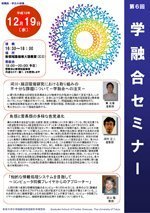AY2007 6th Gakuyugo Seminar
- Date&Time:
- Dec 29, 2007 16:30~18:00
- Venue:
- Large Lecture Room (2C0), New Frontier Science Bldg.

Inadequate Efforts in River and Lake Environmental Research: An Order for Academic Fusion
Associate Professor Guangwei Huang
(a) Migratory bird conservation is extremely important from the perspective of wide-area ecosystem conservation and local culture. However, current research and conservation activities lack the perspective of balancing the environmental capacity of migratory wintering grounds and the number of migratory birds in Japan. Through case studies, we will raise the issue and discuss countermeasures. (b) Topics will include issues related to river use and management from the perspective of coastal environment conservation, and the concept of comprehensive improvement measures to achieve harmony.

Diverse color vision evolution in fishes and primates
Associate Professor Shoji Kawamura
The sense of perceiving different wavelengths of light as different (color vision) differs greatly from animal to animal. Even when looking at the same rainbow, a bird with tetrachromatic color vision will be able to see far more colors than a human with trichromatic color vision. In recent years, there has been progress in elucidating the light sensors (cone photoreceptors) that play a role in color vision in various animals, and it has become clear that the number, type, and expression pattern of these sensors differs among animals. The shallow water environment and forest environment, where the brightness fluctuates constantly, are the cradle of color vision evolution, which is consistent with the fact that fish and primates in particular show remarkable color vision diversity. For example, the fish zebrafish has as many as eight types of cone photoreceptors, and by varying the composition of the photoreceptors expressed in different regions of the retina, they are able to perceive different colors depending on the direction of their gaze, and are thought to be able to recognize much more subtle color tones than we humans. The regulatory mechanism of the optic substance opsin gene that makes this possible has also been found. In addition, the New World monkeys of Central and South America are known to have six different types of color vision within a single species, indicating a close relationship between habitat and acquired color vision. Thus, many interesting research results have been accumulated in recent years on color vision ability. Human color vision should be closely related to the history of forest adaptation in primates, and the advanced and diverse fish color vision is an important model for the evolution of color vision in vertebrates. We are working to elucidate the evolution of diverse color vision adapted to the environment, mainly in fishes and primates. In this seminar, we will introduce recent findings on visual material diversity and its ecological significance in fishes and primates.

Toward an Intelligent Information Processing System: An Approach from Computer Shogi Players
Professor Takashi Chikayama
In order to allow computers to perform the flexible information processing capabilities that humans possess, the conventional method of having humans write programs that define detailed behavior is reaching its limits. In order to compensate for this, the use of machine learning methods is promising. This presentation will introduce research on the application of machine learning techniques, focusing on the application to computer shogi players.
*The contents of this page were developed based on a machine translation.

